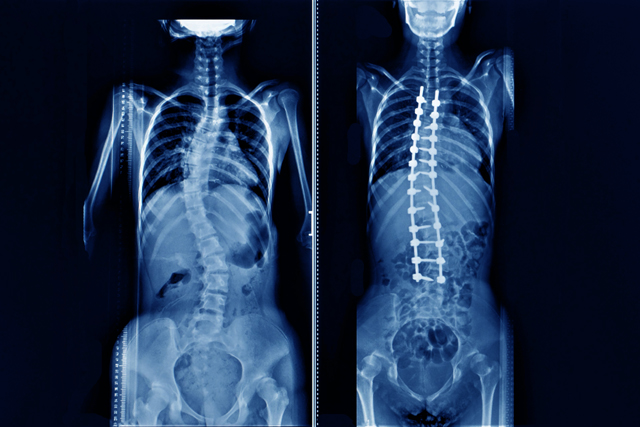
Herbal Medicine Could Be Used for Supportive Treatment
By Namwook Cho L.Ac.
Scoliosis is caused by abnormal lateral curvature or deviation of the spine from the vertical body axis. So far, there are no clear explanations for the causes of the symptoms.
Scoliosis is a three-dimensional deformity, with the rotation of the vertebral body in the coronal plane, often coupled with sagittal spinal curvature disruption. There are two categories of scoliosis: structural scoliosis and non-structural scoliosis, also known as functional scoliosis. Treatment options in conventional therapy include bracing, physical therapy and surgery. Korean medicine therapy applies acupuncture, herbal medicine, and the Tuina therapy.
Recommendations
Herbal medicine: Herbal medicine treatment may be considered over muscle relaxants for pain attenuation and functional improvement in scoliosis.
Herbs such as Eucommiae Cortex(杜沖), Atractylodis Rhizoma Alba(白朮), Corni Fructus(山茱萸) that nourish kidney and spleen(補肝腎), strengthen the bones and muscles(强筋骨), and remove dampness by invigorating the spleen(補脾利濕) may be considered.
Use of prescriptions that have been reported in clinical cases, including Jakyakgamcho-tang(芍藥甘草湯), Dokwhalgisaeng-tang(獨活寄生湯), Gamisayuk-tang(加味四六湯), and Yeongamggangmi shinhain-tang(苓甘薑味辛夏仁湯), Whallak-tang(活絡湯), Cheongpa-jeon(靑破煎), may be considered according to the clinical symptom differentiation.
According to survey on clinical usage, frequently selected prescriptions for scoliosis include Jakyakgamcho-tang(芍藥甘草湯), Ojeok-san(五積散), Yukmijihwang-tang(六味地黃湯), Palmijihwanghwan(八味地黃丸), and Yeonggyechulgam-tang(苓桂朮甘湯), Ssanghwa-tang(雙和湯), Cheongpajeon(靑破煎), and Dokwhalgisaeng-tang(獨活寄生湯). The prescriptions above may be considered according to the clinical symptom differentiation.
Tuina technique, Single treatment
Tuina technique may be considered for symptom improvement and pain attenuation in adolescent idiopathic scoliosis.
The Tuina technique may be considered accordingly depending on the Cobb’s angle and the corresponding spine’s displacement level. Appropriate techniques include the upper thoracic vertebrae fascia Tuina technique (sitting position upper thoracic myofascial release/ strengthening technique), lower and middle thoracic vertebrae adjustment technique (supine position thoracic vertebra extension malposition adjustment technique, prone position lower thoracic spine flexion malposition pisiform correction technique), lower thoracic fascia Tuina technique (sitting position lower thoracic fascia relaxation/strengthening technique), lumbar adjustment technique (side-lying position lumbar dysfunction adjustment technique), and spinal flexion distraction technique.
For patients with scoliosis of mild severity with Cobb’s angle ranging 20~30 degrees, the Tuina technique showed significant symptom improvement compared to bracing treatment or traction. Although bracing is a useful conservative treatment method to prevent the progression of scoliosis, patients have poor therapeutic compliance as it has to be worn for long periods during adolescence, thus hurting the patient’s quality of life psychologically, socially, and functionally. Thus, the Tuina technique may be considered. As adolescent idiopathic scoliosis could progress rapidly, it is necessary to closely monitor the growth of the patient together with the curve progression of scoliosis to apply appropriate treatment accordingly.
Acupuncture+exercise: Combined acupuncture treatment with exercise should be considered for symptom improvement in scoliosis.
Acupuncture points from governing vessel(督脈) or bladder meridian(足太陽膀胱經) and Ashi points(阿是穴), should be considered. Furthermore, Back-shu points(背兪穴) at the height of the vertebral body where scoliosis or pain is observed, Hyeopcheok-points(夾脊穴), GV20, BL60, BL67, ST36, KI3, SI3 should be considered. Additional acupuncture treatment for relieving pain due to muscular asymmetry should also be considered.
In patients with mild scoliosis(20-30 degrees), combined treatment with acupuncture and exercise has shown significant symptom improvement over exercise alone or with bracing treatment. Since scoliosis can progress rapidly, it is necessary to closely monitor the patient’s progress and perform appropriate treatment according to the situation. As scoliosis could progress rapidly, it is necessary to closely monitor curve progression of scoliosis and apply appropriate treatment accordingly.
Acupuncture+Tuina technique: Combined acupuncture treatment with the Tuina technique should be considered for symptom and functional improvement and psychological stability in adolescent idiopathic scoliosis.
For patients with mild scoliosis with Cobb’s angle of approximately 20 degrees, the patient group that received combined treatment of acupuncture and Tuina technique showed significant improvement compared to no treatment group, single treatment group that received either electroacupuncture or Tuina or treatment group that received bracing treatment with traction.
Integrative Korean medicine treatment, including the Tuina technique
Tuina technique+exercise: For symptom improvement of adolescent idiopathic scoliosis, combined treatment of the Tuina technique and exercise is recommended based on the clinical practice guide development group consensus.
Tuina and exercise combined treatment showed significant symptom improvement compared to exercise treatment alone, whereas bracing treatment was reported to have clinical significance over this combined treatment. Nevertheless, Tuina and exercise combined treatment showed significant improvement compared to bracing in scales measuring depression and anger levels.
Therefore, careful decision-making seems necessary, considering the psychological discomfort of scoliosis patients.
Tuina technique+traction: Combined treatment of the Tuina technique with traction should be considered for symptom improvement in adolescent idiopathic scoliosis.
Traction therapy can control the unbalanced weight load on the vertebral body affected by scoliosis by reducing the pressure on the surrounding tissues with the traction force applied to the spine.
However, caution is required as excessive traction force can cause damage and instability of ligaments or facet joints.
For patients with mild scoliosis with Cobb’s angle of approximately 20 degrees, the group that received the combined Tuina technique and traction treatment showed significant improvement compared to the group that received bracing and traction therapy.
Although bracing is a useful conservative treatment method to prevent the progression of scoliosis, patients have poor therapeutic compliance as it has to be worn for long periods during adolescence, thus having a negative effect on the patient’s quality of life psychologically,
socially, and functionally. Thus, combined treatment of the Tuina technique with traction should be considered. As adolescent idiopathic scoliosis could progress rapidly, it is necessary to closely monitor the growth of the patient together with the curve progression of scoliosis to apply appropriate treatment accordingly.
Clinical Practice Guideline of Korean Medicine, Deforming Dorsopathies (Scoliosis)





































